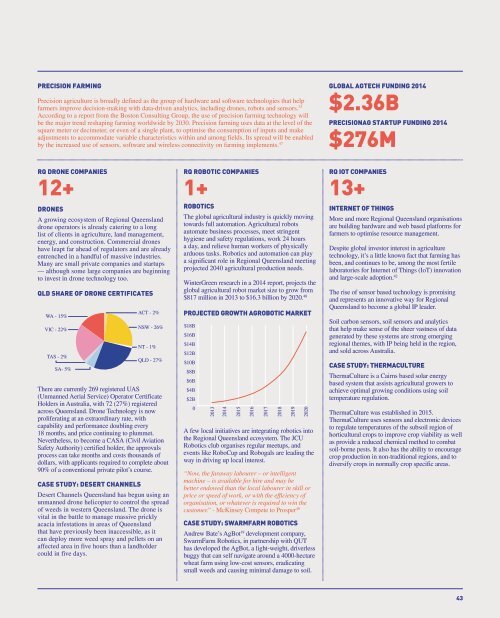STARTUP ECOSYSTEM REPORT
ogpe302pAOT
ogpe302pAOT
You also want an ePaper? Increase the reach of your titles
YUMPU automatically turns print PDFs into web optimized ePapers that Google loves.
PRECISION FARMING<br />
Precision agriculture is broadly defined as the group of hardware and software technologies that help<br />
farmers improve decision-making with data-driven analytics, including drones, robots and sensors. 35<br />
According to a report from the Boston Consulting Group, the use of precision farming technology will<br />
be the major trend reshaping farming worldwide by 2030. Precision farming uses data at the level of the<br />
square meter or decimeter, or even of a single plant, to optimise the consumption of inputs and make<br />
adjustments to accommodate variable characteristics within and among fields. Its spread will be enabled<br />
by the increased use of sensors, software and wireless connectivity on farming implements. 47<br />
GLOBAL AGTECH FUNDING 2014<br />
$2.36B<br />
PRECISIONAG <strong>STARTUP</strong> FUNDING 2014<br />
$276M<br />
RQ DRONE COMPANIES<br />
12+<br />
DRONES<br />
A growing ecosystem of Regional Queensland<br />
drone operators is already catering to a long<br />
list of clients in agriculture, land management,<br />
energy, and construction. Commercial drones<br />
have leapt far ahead of regulators and are already<br />
entrenched in a handful of massive industries.<br />
Many are small private companies and startups<br />
— although some large companies are beginning<br />
to invest in drone technology too.<br />
QLD SHARE OF DRONE CERTIFICATES<br />
WA - 15%<br />
VIC - 22%<br />
TAS - 2%<br />
SA- 5%<br />
There are currently 269 registered UAS<br />
(Unmanned Aerial Service) Operator Certificate<br />
Holders in Australia, with 72 (27%) registered<br />
across Queensland. Drone Technology is now<br />
proliferating at an extraordinary rate, with<br />
capability and performance doubling every<br />
18 months, and price continuing to plummet.<br />
Nevertheless, to become a CASA (Civil Aviation<br />
Safety Authority) certified holder, the approvals<br />
process can take months and costs thousands of<br />
dollars, with applicants required to complete about<br />
90% of a conventional private pilot’s course.<br />
CASE STUDY: DESERT CHANNELS<br />
ACT - 2%<br />
NSW - 26%<br />
NT - 1%<br />
QLD - 27%<br />
Desert Channels Queensland has begun using an<br />
unmanned drone helicopter to control the spread<br />
of weeds in western Queensland. The drone is<br />
vital in the battle to manage massive prickly<br />
acacia infestations in areas of Queensland<br />
that have previously been inaccessible, as it<br />
can deploy more weed spray and pellets on an<br />
affected area in five hours than a landholder<br />
could in five days.<br />
RQ ROBOTIC COMPANIES<br />
1+<br />
ROBOTICS<br />
The global agricultural industry is quickly moving<br />
towards full automation. Agricultural robots<br />
automate business processes, meet stringent<br />
hygiene and safety regulations, work 24 hours<br />
a day, and relieve human workers of physically<br />
arduous tasks. Robotics and automation can play<br />
a significant role in Regional Queensland meeting<br />
projected 2040 agricultural production needs.<br />
WinterGreen research in a 2014 report, projects the<br />
global agricultural robot market size to grow from<br />
$817 million in 2013 to $16.3 billion by 2020. 48<br />
PROJECTED GROWTH AGROBOTIC MARKET<br />
$18B<br />
$16B<br />
$14B<br />
$12B<br />
$10B<br />
$8B<br />
$6B<br />
$4B<br />
$2B<br />
0<br />
2013<br />
2014<br />
2015<br />
2016<br />
2017<br />
2018<br />
2019<br />
A few local initiatives are integrating robotics into<br />
the Regional Queensland ecosystem. The JCU<br />
Robotics club organises regular meetups, and<br />
events like RoboCup and Robogals are leading the<br />
way in driving up local interest.<br />
“Now, the faraway labourer – or intelligent<br />
machine – is available for hire and may be<br />
better endowed than the local labourer in skill or<br />
price or speed of work, or with the efficiency of<br />
organisation, or whatever is required to win the<br />
customer.” - McKinsey Compete to Prosper 49<br />
CASE STUDY: SWARMFARM ROBOTICS<br />
2020<br />
Andrew Bate’s AgBot 19 development company,<br />
SwarmFarm Robotics, in partnership with QUT<br />
has developed the AgBot, a light-weight, driverless<br />
buggy that can self navigate around a 4000-hectare<br />
wheat farm using low-cost sensors, eradicating<br />
small weeds and causing minimal damage to soil.<br />
RQ IOT COMPANIES<br />
13+<br />
INTERNET OF THINGS<br />
More and more Regional Queensland organisations<br />
are building hardware and web based platforms for<br />
farmers to optimise resource management.<br />
Despite global investor interest in agriculture<br />
technology, it’s a little known fact that farming has<br />
been, and continues to be, among the most fertile<br />
laboratories for Internet of Things (IoT) innovation<br />
and large-scale adoption. 42<br />
The rise of sensor based technology is promising<br />
and represents an innovative way for Regional<br />
Queensland to become a global IP leader.<br />
Soil carbon sensors, soil sensors and analytics<br />
that help make sense of the sheer vastness of data<br />
generated by these systems are strong emerging<br />
regional themes, with IP being held in the region,<br />
and sold across Australia.<br />
CASE STUDY: THERMACULTURE<br />
ThermaCulture is a Cairns based solar energy<br />
based system that assists agricultural growers to<br />
achieve optimal growing conditions using soil<br />
temperature regulation.<br />
ThermaCulture was established in 2015.<br />
ThermaCulture uses sensors and electronic devices<br />
to regulate temperatures of the subsoil region of<br />
horticultural crops to improve crop viability as well<br />
as provide a reduced chemical method to combat<br />
soil-borne pests. It also has the ability to encourage<br />
crop production in non-traditional regions, and to<br />
diversify crops in normally crop specific areas.<br />
43


